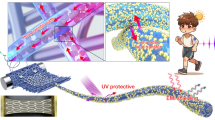Abstract
The study of on-body energy harvesting is most often focused on improving and optimizing the energy harvester. However, other factors play a critical factor in the energy harvesting integration techniques of the harvester to close-to body materials of the wearable device. In addition, one must recognize the wide array of human factors and ergonomic factors that lead a variation of the energy harvesting. In this work, key affecting variables at varying on-body locations are investigated for commercial thermoelectric generators (TEGs) integrated within a textile-based wearable platform. For this study, a headband and an armband is demonstrated with five TEGs connected in series in a flexible form factor via Pyralux®. These platforms enable comparison of the amount of energy harvested from the forehead versus the upper arm during various external conditions and movement profiles, e.g. running, walking, and stationary for periods of up to 60 minutes. During these tests, ambient temperature, ambient humidity, accelerometry, and instantaneous power are recorded live during the activity and correlated to the energy harvested. Human factors such as skin temperature and application pressure were also analyzed. Our analysis demonstrates that vigorous movement can generate over 100 μW of instantaneous power from the headband and up to 35 μW from the armband. During the stationary movement profile, the instantaneous power levels of both the headband and the armband decreased to a negligible value. Our studies show that for higher intensities of movement, air convection on the cool side of the TEG is the dominating variable whereas the temperature gradient has a significant effect when the subject is stationary. This work demonstrates key materials and design factors in on-body thermoelectric energy harvesting that allows for a strategic approach to improving the integration of the TEGs.
Similar content being viewed by others
References
V. Misra, A. Bozkurt, B. Calhoun, T. Jackson, J. Jur, J. Lach, B. Lee, J. Muth, O. Oralkan, M. Ozturk, S. Trolier-McKinstry, D. Vashaee, D. Wentzloff, and Y. Zhu, “Flexible technologies for self-powered wearable health and environmental sensing,” Proc. IEEE, vol. 103, no. 4, pp. 665–681, 2015.
T. Starner and J. Paradiso, “Human generated power for mobile electronics,” Low-power Electron. Des., vol. 1990, 2004.
V. Leonov and R. J. M. Vullers, “Wearable Thermoelectric Generators for Body-Powered Devices,” J. Electron. Mater., vol. 38, no. 7, pp. 1491–1498, Jan. 2009.
A. Harb, “Energy harvesting: State-of-the-art,” Renew. Energy, vol. 36, no. 10, pp. 2641–2654, Oct. 2011.
B. P. D. Mitcheson, M. Ieee, E. M. Yeatman, S. M. Ieee, G. K. Rao, S. M. Ieee, A. S. Holmes, and T. C. Green, “Energy Harvesting From Human and Machine Motion forWireless Electronic Devices,” vol. 96, no. 9, pp. 1457–1486, 2008.
M. Wahbah, M. Alhawari, B. Mohammad, H. Saleh, and M. Ismail, “Characterization of Human Body-Based Thermal and Vibration Energy Harvesting for Wearable Devices,” IEEE J. Emerg. Sel. Top. Circuits Syst., vol. 4, no. 3, pp. 354–363, Sep. 2014.
J. W. Stevens, “Optimal design of small ΔT thermoelectric generation systems,” Energy Convers. Manag., vol. 42, no. 6, pp. 709–720, Apr. 2001.
V. Leonov and R. J. M. Vullers, “Wearable electronics self-powered by using human body heat: The state of the art and the perspective,” J. Renew. Sustain. Energy, vol. 1, no. 6, p. 062701, 2009.
V. Leonov, C. Van Hoof, and R. J. M. Vullers, “Thermoelectric and Hybrid Generators in Wearable Devices and Clothes,” in 2009 Sixth International Workshop on Wearable and Implantable Body Sensor Networks, 2009, pp. 195–200.
V. Leonov, “Energy Harvesting for Self-Powered Wearable Devices,” in Wearable Monitoring Systems, A. Bonfiglio and D. De Rossi, Eds. Boston, MA: Springer US, 2011, pp. 27–49.
M. Lossec, B. Multon, and H. Ben Ahmed, “Sizing optimization of a thermoelectric generator set with heatsink for harvesting human body heat,” Energy Convers. Manag., vol. 68, pp. 260–265, Apr. 2013.
Author information
Authors and Affiliations
Rights and permissions
About this article
Cite this article
Myers, A., Hodges, R. & Jur, J.S. Human and Environment Influences on Thermoelectric Energy Harvesting Toward Self-Powered Textile-Integrated Wearable Devices. MRS Advances 1, 2665–2670 (2016). https://doi.org/10.1557/adv.2016.316
Published:
Issue Date:
DOI: https://doi.org/10.1557/adv.2016.316




